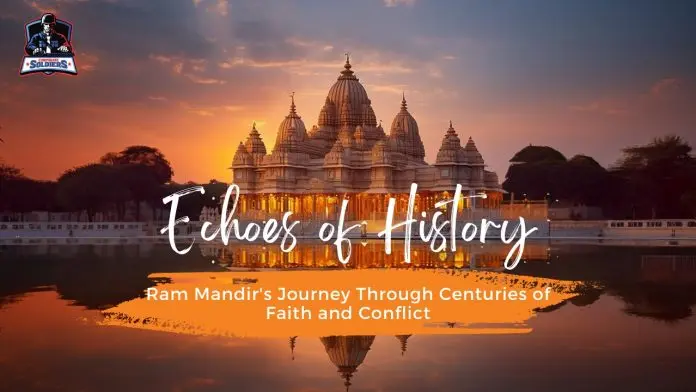The Ram Janmabhoomi site in Ayodhya, Uttar Pradesh, is believed by some Hindus to be Rama’s birthplace, mentioned in the Ramayana on the banks of the Sarayu river. This site was previously occupied by the Babri Masjid until its demolition in 1992, sparking significant Hindu-Muslim tensions. Following extensive legal disputes, the Indian Supreme Court ruled in November 2019 to allocate the land to a trust for the construction of a Hindu temple, citing archaeological findings of a pre-existing Hindu temple beneath the mosque’s structure as part of the decision-making process.
Historical Significance
The historical background of the Ram Mandir in Ayodhya is deeply rooted in Hindu mythology and centuries-old beliefs. Ayodhya is believed to be the birthplace of Lord Ram, a significant deity in Hinduism revered as an incarnation of the god Vishnu.
According to Hindu epics like the Ramayana, Ayodhya was the capital of the ancient Kosala Kingdom and the birthplace of Lord Ram. The Ramayana narrates the life and adventures of Lord Ram, including his exile, the abduction of his wife Sita by the demon king Ravana, and the eventual triumph of good over evil.
The site where the Ram Mandir stands, known as the Ram Janmabhoomi, is believed to be the very spot where Lord Ram was born. Historically, there stood a structure called the Babri Masjid, believed to have been built in the 16th century by Mir Baqi, a general in the Mughal Emperor Babur’s army. The controversy arose as Hindu groups claimed that the mosque was constructed after demolishing a pre-existing temple believed to be Lord Ram’s birthplace.
The dispute over the site led to decades of legal battles and communal tensions. The issue gained significant attention and became a focal point of religious and political debates in India.
The historical background of the Ram Mandir is thus a blend of mythology, religious beliefs, and a complex historical narrative that has fueled a contentious dispute over the site for centuries.
Supreme Court Verdict : Resolution of Land Dispute
The verdict regarding the Ram Mandir in Ayodhya was a landmark decision by the Supreme Court of India in November 2019. The court ruled in favor of the construction of a Ram Mandir at the disputed site in Ayodhya. Simultaneously, it directed the allocation of an alternate piece of land to the Muslim Sunni Waqf Board for the construction of a mosque.
The verdict was based on a culmination of historical, archaeological, and legal perspectives. The court acknowledged the significance of the site in Hindu belief as the birthplace of Lord Ram. It also recognized that the demolition of the Babri Masjid in 1992 was illegal and a violation of the law.
Following the Supreme Court’s decision, the groundbreaking ceremony for the construction of the Ram Mandir took place in August 2020. The event was attended by various political and religious figures, marking the formal initiation of the temple’s construction.
The construction of the Ram Mandir aims to fulfill the long-standing aspirations of millions of Hindus and to create a grand religious complex at the Ram Janmabhoomi site. The plan includes the construction of a magnificent temple complex with intricate architectural designs and grandeur befitting the cultural and religious significance attached to Lord Ram. This initiative is seen as a significant moment in Indian history and holds deep religious and emotional importance for many people across the country.
Architectural Design
The architectural design of the Ram Mandir in Ayodhya showcases a blend of traditional and modern styles, reflecting the rich cultural and religious heritage associated with Lord Ram.
The temple’s design draws inspiration from ancient Hindu temple architecture, particularly the Nagara style prevalent in North India. It features intricate carvings, ornate pillars, domes, and spires, creating a majestic and awe-inspiring structure.
The main temple complex is planned to have multiple mandaps (halls) and sanctums dedicated to various deities, with the central sanctum housing the idol of Lord Ram. The structure will be constructed using modern techniques while adhering to traditional Vastu and architectural principles.
The proposed design includes intricate carvings depicting scenes from the Ramayana and other mythological narratives associated with Lord Ram’s life. The temple’s grandeur is expected to be enhanced by the use of high-quality materials and skilled craftsmanship.
Moreover, the overall layout and architecture of the complex aim to accommodate large gatherings of devotees and visitors, providing spaces for prayers, rituals, and cultural activities. The construction of the Ram Mandir is envisioned to be an architectural masterpiece, symbolizing the reverence and devotion towards Lord Ram.
Cultural and Religious Importance of Ram Mandir Ayodhya:
- Spiritual Epicenter : The Ram Mandir in Ayodhya holds immense cultural significance as it’s believed to be the birthplace of Lord Ram, a revered deity in Hinduism.
- Symbol of Faith : It represents the faith and devotion of millions of Hindus worldwide, signifying the triumph of righteousness over evil as depicted in the epic Ramayana.
- Historical Legacy: The temple’s construction at Ram Janmabhoomi site resolves a longstanding dispute, marking a pivotal moment in Indian history and symbolizing religious harmony.
- Cultural Celebrations: The temple is a focal point for various religious and cultural celebrations, attracting devotees who participate in rituals, festivals, and prayers dedicated to Lord Ram.
- Tourist Attraction: It draws tourists and pilgrims from diverse backgrounds, contributing to the cultural fabric of Ayodhya and bolstering the region’s tourism and economy.
- National Unity: Its construction signifies unity, respect for diverse beliefs, and the preservation of cultural heritage, fostering a sense of unity among people irrespective of religious affiliations.
The construction of the Ram Mandir in Ayodhya has profoundly impacted the community. It has stirred emotions and strengthened religious sentiments among locals, fostering a sense of unity and pride. Economically, it has boosted tourism, offering employment opportunities and aiding local businesses. However, it also evokes complex emotions, reminding some of past disputes. Overall, the temple’s construction has influenced the socio-cultural landscape, amplifying religious fervor, economic prospects, and a mix of emotions, shaping the community’s identity and future trajectory.










